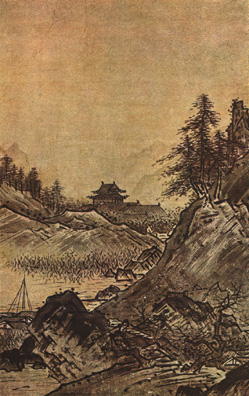- Sesshū Tōyō
Infobox Buddhist biography
name = Sesshū Tōyō

img_size =
img_capt = Shukei-sansui (Autumn Landscape), by Sesshu Toyo
landscape =
birth_name =
other_names =
dharma_name =
birth_date = 1420
birth_place = Bitchū,Japan
death_date = 1506
death_place =
nationality =
denomination =
school =Rinzai
lineage =
title =suibokuga masterZen Master
workplace =
education =
occupation =
teacher =
reincarnation_of =
predecessor =
successor =
student =
spouse =
partner =
children =
website =nihongo|Sesshū Tōyō|雪舟 等楊|lit.: snow boat or often also simply Sesshū, 1420-1506, was one of the most prominent masters of "
suibokuga " (ink painting), and aRinzai Zen Buddhist priest. Although born into thesamurai Ōta clan , he is famous for his mastery of Chinese-style ink painting.Appert, Georges. (1888). [http://books.google.com/books?id=HYc_AAAAMAAJ&printsec=titlepage&dq=ancien+japon&source=gbs_summary_r#PPA80,M1 "Ancien Japon," p. 80.] ] He established an individual identity as a painter.Ōta clan genealogy
The
Ōta clan originated in 15th centuryMusashi province .Appert, [http://books.google.com/books?id=CSUNAAAAYAAJ&printsec=frontcover&dq=ancien+japon+georges+appert&lr=#PPA76,M1 "Ancien Japon," p. 76.] ] They claimed descent fromMinamoto Yorimasa , and through that branch of the Minamoto they claimed kinship with theSeiwa-Genji .Papinot, Jacques. (2003). [http://www.unterstein.net/Toyoashihara-no-Chiaki-Nagaioaki-no-Mitsuho-no-Kuni/NobiliaireJapon.pdf "Nobiliare du Japon" -- Ōta, pp. 48;] Papinot, Jacques Edmond Joseph. (1906). "Dictionnaire d’histoire et de géographie du Japon." (in French/German).]The feudal progenator of the clan name,
Ōta Sukekuni , established himself atŌta inTamba province , and he adopted this location name as his own. He traced his lineage as a 5th generation descendant of Yorimasa. [see above] ]In a special context created by the
Tokugawa shogunate , the Ōta clan were identified as "tozama " or outsiders, in contrast with the "fudai " or insider "daimyō" clans which were hereditary vassels or allies of the Tokugawas. [see above] ]In, 1638,
Ōta Sukemune , the grandson ofŌta Yasusuke , was grantedNishio Domain inMikawa province ; and then, in 1645, he and his family was transferred toHamamatsu Domain (35,000 "koku") inTōtōmi province . Yasusuke's descendants were moved several times by shogunate decree, residing successively in 1687 atTanaka Domain inSuruga province , in 1703 atTanakura Domain inMutsu province , and in 1728 atTatebayashi Domain inKōzuke province . [see above] ] Then, in the period spanning the years 1746 through 1868, this branch of the Ōta clan established itself atKakegawa Domain (53,000 "koku") [Papinot, [http://www.unterstein.net/Toyoashihara-no-Chiaki-Nagaioaki-no-Mitsuho-no-Kuni/NobiliaireJapon.pdf p. 48.] ] in Tōtōmi. [see above] ]The head of this clan line was ennobled as a "Viscount" in the Meiji period. [see above] ]
Career
Sesshū was born in Bitchū, present-day
Okayama Prefecture . He studiedZen in his youth atHōfuku-ji located in Sōja City, Okayama. Later moving toShōkoku-ji in Kyoto, he continued to study Zen, and learned painting from Shūbun as well. Sesshū studied in Ming (China) for some years in the 1460s. After returning to Japan in 1469, he built an atelier inYamaguchi Prefecture , named nihongo|"Unkoku-an"|雲谷庵|. [see above] ] This became the base from which he traveled around Japan. It is generally believed that he based his activities in the atelier for most of his later life.Cite web|url=http://www.city.soja.okayama.jp/kanko/kankochi/sesshu500.jsp|title=雪舟没後500年顕彰 (500th memorial of Sesshū's death)|accessdate=2007-04-18|publisher=City of Soja|language=Japanese] Some believe that he died onAugust 8 , 1506, though precisely where still remains unknown. [see above] ]Paintings
There are six paintings, which are widely confirmed to be works by Sesshū, designated as National Treasures in Japan. Besides these, there are numerous other works attributed to him, with some varied views among experts. Those most influenced by his approach to painting are said to be the "School of Sesshū" or the "Unkoku-rin" School." [Appert, [http://books.google.com/books?id=HYc_AAAAMAAJ&printsec=titlepage&dq=ancien+japon&source=gbs_summary_r#PPA3,M1 p. 3] -4.]
Some of his works existing today reside in:
*The Freer Gallery,Washington, D.C.
*The Museum of Fine Arts inBoston , Mass.
*The National Museum of Tokyo Cite web|url=http://www.emuseum.jp/cgi/pkihon.cgi?SyoID=2&ID=w056&SubID=s000|title=Landscape with ink broken|accessdate=2007-04-18|publisher=Tokyo National Museum]ee also
*Shūbun
*Buddhism in Japan
*List of Rinzai Buddhists Notes
References
* Appert, Georges and H. Kinoshita. (1888). [http://books.google.com/books?id=HYc_AAAAMAAJ&dq=ancien+japon&source=gbs_summary_s&cad=0 "Ancien Japon."] Tokyo: Imprimerie Kokubunsha.
* Papinot, Jacques Edmund Joseph. (1906) "Dictionnaire d'histoire et de géographie du japon." Tokyo: Librarie Sansaisha. [http://www.unterstein.net/Toyoashihara-no-Chiaki-Nagaioaki-no-Mitsuho-no-Kuni/NobiliaireJapon.pdf ..Click link for digitized 1906 "Nobiliaire du japon" (2003)]External links
**
Yomiuri Shimbun : [http://www.yomiuri.co.jp/dy/national/20080628TDY01306.htm Sesshū -- slightly less than 90% name recognition amongst primary school students in Japan] , 2008.
Wikimedia Foundation. 2010.
